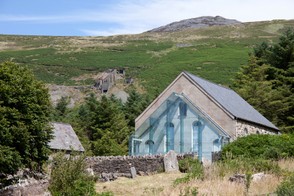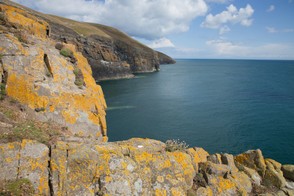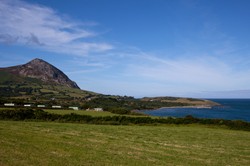I walked, or more like scrambled up the ancient earthen ramparts of Dinas Dinlle, a deserted Iron Age fort left now to the unrelenting mercies of the sea, which has eroded part of it away. You do not find any great mysteries in archaeological sites, so the visitor who only sees the surface will be disappointed. Such sites are places to sit and think, reliving the past as it was seen by the ancients. The fort guarded the entry to the Menai Straits from unwelcome visitors, often Irish pirates who were enthusiastic participants in the internecine strife that besmirched the British Isles. Later, as pottery finds reveal, the Romans used the site as a signal station. But the Romans went and the Irish came, the southern Irish kingdom of Leinster capturing the fertile land, hence its enduring name Lleyn, after Leinster. But the Welsh regrouped and conquered the small Irish settlements that had sprung up in the post-Roman period and the land reverted to being part of Wales.
The north coast of the Lleyn contains a variety of walks. They begin after Dinas Dinlle, and walkers can stroll along a level landscape until they come to the rockier ends of the land, where going becomes tougher. I chose the beach with its soft sand and warm south westerly breeze gusting in my face. Ahead were the blue hazed hills of the western part of the Lleyn that provide an enchanting aspect to the walk. Then as the fast-flowing tide began to flow I retraced my route down quiet lanes along the coast.
Wales is a country with a continuous coastal path from Chester in the North to Chepstow in the South, and eighty of those miles are the Lleyn Peninsula, and that's not taking into account the Lleyn's interior, with its network of lanes and footpaths. The North side looks over the Irish Sea and the South overlooks Cardigan Bay, the wide expanse of shallow water that stretches down towards distant Pembrokeshire. At the tip you espy Ynys Enlli, Bardsey, the island of ten thousand saints, the destination of centuries of mediaeval pilgrims at the end of a route that led through Wales, a sacred monastic isle to be reached only by crossing some difficult water. Now managed by the Bardsey Island Trust it has a resident warden who protects the large seabird colonies that thrive on its lonely shores, but the monks are no more.
But the Western tip of the peninsula contains Hell's Mouth, a bay that has proved the graveyard of many a sailing ship. In the days before steam ships sailing down the turbulent Irish Sea dreaded being wind driven into the Hell's mouth by the powerful South Westerly gales that drive up across Ireland, for there was no safe harbour there and no way out. When standing on the cliffs above this bay, reflect on the ships, sailors and passengers who died there. It is a sobering thought to realize that such beautiful places are sometimes so dangerous.







 Pilgrimage. A review25 days ago
Pilgrimage. A review25 days ago
 Leo the Fourteenthon 05/09/2025
Leo the Fourteenthon 05/09/2025
 The Melsonby Hoardon 03/25/2025
The Melsonby Hoardon 03/25/2025



Comments
Mainly traditional vegetable crops, poultry and maybe some sheep or goats. Occasionally new vegetables, such as okra, make a new crop, but the old ones are good enough.
Thank you!
Unitedstatesian small-scale farmers can find it economical for their household and profitable for their sales to grow local, traditional crops such as the three southwest sisters' beans, corn and squashes and such as the four and the five Massachusetts sisters' beams, bee balm and/or sunflower, corn and squashes.
What might North Wales' agricultural-interior, small-scale farmers grow for household use and local-market traditional food sales?
Online sources seem to suggest barley, cabbage, leeks, oats, potatoes and wheat as traditional crops for local-serving, tradition-spirited Welsh crops and meals.
Would that be possible or would there be more or somethings else?
Small scale farmers operate on the same model as US farmers.
Thank you!
Small Unitedstatesian farms can be owner-operated or renter-occupied by those who delight in self-sufficiency or in rural or suburban grocery supplier-ship or in small farmer market sales.
Might that be what North Wales' agricultural-interior farmers practice?
A mixture. Much farmland is owned by large estates and rented out.
The first sentence to your introduction considers that "The Lleyn Peninsula is the extremity of North Wales, a long stretch of open countryside with small coastal towns on its fringe, but with a large, agricultural interior of small farms, quiet lanes and ancient remains through which hikers can wander."
Is the agricultural interior one of occupant-rented or owner-occupied small farms?
This information is new to me. Sorry
Thank you!
English Wikipedia addresses as non-fact-based tradition Fleance, Banquo's son in the Shakespearian play Macbeth, arriving in Wales and being awarded as his wife Nesta, Gruffydd ap Llywelyn's daughter. That article attributes a genealogical association between Nesta (through her father or her mother?) and King Arthur.
What do Welsh traditions say?
No. Llyn is Welsh for lake and is found in place names in Wales and in parts of Western England, e.g. Lindow, about 12 miles from my home, which was originally Llyn Dhu, the Dark Lake. Lleyn derives its name from Legin, pronounced Lein, which is the Irish for Leinster. The Irish kingdom of Leinster [Norse for Lein's land] once incorporated the Lleyn peninsula for a period until the Welsh recaptured it.
Place names of Welsh origin are found in the West of England along with names of Anglo-Saxon origin are found in the Western area, as they hark back to a time Wales extended eastwards and when Welsh was spoken there into the the timwhen es of Saxon rule.
The first paragraph in the second subheading, Places of Interest, alerts us to the pronunciation of lleyn as "clean."
English Wiktionary offers only the Welsh word llyn ("lake") from the Middle Welsh word llynn ("upland lake").
Would that be its meaning on the Lleyn Peninsula?